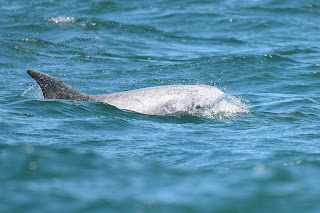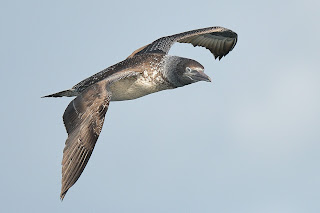Weather, it's always something we obsess about as we approach a scheduled trip. This past weekend with two out of three trips to run there was a bit more pressure than usual - but we made it out on both trips. And WOW were we rewarded... It was blowing right up until Saturday morning and the Oregon Inlet bar looked a bit iffy as we crossed the bridge on our way up to Wanchese. We gave the swell a little time to fall out and then headed out, making it to the ocean less than thirty minutes later than usual. Winds were predicted to pick up again in the afternoon and the tide was going to be low - yes, wind + shallow water = larger seas. So we were in a little early but it's possible no one was too upset about it since we found nine target species during our foray to the south east then north east of Oregon Inlet. We knew Saturday morning that Sunday wouldn't be fit to go so pushed that trip back to Monday. Two participants couldn't make it so we had space for the Stoll brothers to join who had been scheduled for an earlier trip this winter that was weathered out. Monday was unbelievably beautiful offshore, light winds, sunny skies and close to glassy calm seas by the end of the day. Perfect conditions for detecting alcids. And for finding more Atlantic Puffins than have ever been seen in a day in North Carolina: 302!! A day with six target species. Those who joined us for the set not only saw those nine target species of seabirds but also four species of cetaceans and two species of sea turtles! A weekend for the lucky. (Atlantic Puffin, Kate Sutherland)
Great Skua is a target species for most everyone who comes offshore with us in the winter. We don't usually expect to see them on "bluebird sky" days, but we had at least two individuals each day come to the boat. When it's sunny like it was this weekend they will come in from the glare to maximize their stealth as they wage an attack on the gull flock. It looks like the same individual buzzed us closely each trip with two other individuals photographed at a bit more of a distance. THREE Great Skuas aka Bonxies over two trips. Not bad. (Kate Sutherland)
Atlantic Puffins are always fun to see, but we don't see them every year and we certainly don't have an influx every year. So when we tallied 166 on our first trip of the season, February 7th, we were super excited to have broken the record for the most seen in one day in North Carolina. We found 118 on Saturday's trip. So almost doubling that high count on Monday? It was astounding. Monday the conditions were just right for us to be able to spot these small, dark alcids with their dusky faces and thicker bills at quite a distance. Most of the birds we encountered were either juveniles or immatures which is what we typically find here in the winter, remember that alcids drop their flight feathers after breeding so those adults are flightless for a period after breeding. It was incredible to scan around the boat and see small groups of up to seven or nine swimming along. Some were mixed in with Razorbill and Bonaparte Gull flocks which was cool to see. Brian took a photo of the bottom machine close to where we found our first puffins and you could see why they might be in the area! (Brian Patteson)
Razorbills were the most common alcid we saw on both trips with high tallies each day - we could have been low on those counts too, it was really challenging to keep up with them as they buzzed around closer to the beach. Luck was with us and we found super cooperative Thick-billed Murres (Kate Sutherland top, Saturday's bird, Peter Flood bottom, Monday's bird) on each trip with an additional fly-by imbedded with a Razorbill flock on Saturday seen only later in photos taken by some of our participants. We also had a fly-by Common Murre on Saturday but it was not seen well, nor was it seen by everyone, so luck was with us Monday when we found 12 of them with a number of cooperative individuals! (Kate Sutherland)
Gulls and gannets were around each day with some that were attentive to the chum and others, like the Bonaparte's Gulls, that were actively feeding along rips and foam lines. Saturday's trip was lucky enough to have our persistence pay off with four Little Gull sightings, the final of which was long enough for us to get everyone on these petite gulls with their dark underwings (yes, all four were adults!). White-winged gulls have been in short supply this winter so we were very happy to have not one but two Kumlien's Gulls join our feeding flock on Saturday! They were both with us at the same time, one a bit darker than the other. Kumlien's Gulls are what we typically see here in the winter, a true Iceland Gull will not show any pigment in the primaries. (Ed Corey)
Manx Shearwaters have certainly been around offshore from Oregon Inlet this winter and we were lucky to see them on both trips. Each day we saw just a handful as we headed offshore with some joining our gull flock and feeding on fish and others working tide lines closer to the inlet in the afternoon. (Ed Corey) These tubenoses are always a treat to see and having them zipping around with the gulls behind the boat really illustrates their ability to maneuver easily in the marine environment.
Saturday brought another very cool sighting, one that we've not seen in many years...a Basking Shark! I spotted this animal in a slick at first just catching glimpses of the large, blunt looking dorsal fin. As we got closer we could see the enormity of this filter feeder under the surface and we observed it as it swam along, mouth agape (you can see the mouth in this image by Peter Flood), filtering plankton from the surface waters. The gills on these sharks almost encircle its head (you can see them in this image by Kate Sutherland) and they are the only species of shark to feed as they swim with water moving through their gills versus actively taking water in like the other two planktivorous shark species - the Whale Shark and Megamouth Shark. Awesome to see one of these after so long and to have such a cooperative individual! This species has been declining in recent years globally and IUCN (the International Union for the Conservation of Nature) lists them as Endangered on their Red List (2018).
In addition to our Basking Shark on Saturday we had Risso's Dolphins on Saturday, a small pod in fairly shallow water closer to shore than we typically expect to find them. (Kate Sutherland)Bottlenose Dolphins were around on Saturday, but we seemingly saw them everywhere on Monday! We also had a single Humpback Whale near the inlet in the afternoon on Saturday and were treated to some Atlantic Spotted Dolphins on Monday. Loggerhead Turtles were seen on Monday and super cooperative in the calm seas! (Kate Sutherland)Leader Peter Flood even saw a Kemp's Ridley swim by as well.
Overall it was a great set of trips. Thanks so much to everyone who joined us out there and made these trips possible! A huge thank you as well to our leaders Peter Flood, Ed Corey, and Jacob Farmer for helping us lead the trips. All photos today are by Kate Sutherland, Peter Flood, and Ed Corey except for the one noted by Brian Patteson of the bottom machine!
Species List February 19 / 21
Surf / Black Scoter - 4 / 0
Red Phalarope - 5 / 0
Great Skua - 2 to 3 / 2
Common Murre - 1 / 12
Thick-billed Murre - 2 / 1
Razorbill - 859 / 1,324
large alcid sp. - 2 / 1
Atlantic Puffin - 118 / 302
Bonaparte's Gull - 1,002 / 1,129
Litte Gull - 4 / 0
Ring-billed Gull - 2 / 2
Herring Gull - 280 / 320
Kumlien's Gull - 2 / 0
Lesser Black-backed Gull - 15 / 12 to 15
Great Black-backed Gull - 12 / 5 to 7
Red-throated Loon - 21 / 30
Common Loon - 3 / 39
Manx Shearwater - 14 / 20
Northern Gannet - 230 / 139
Brown Pelican - 10 / 5
Humpback Whale - 1 / 0
Risso's Dolphin - 5 to 8 / 0
Atlantic Spotted Dolphin - 0 / 6
Bottlenose Dolphin - 35 / 100 to 125
Basking Shark - 1 / 0
Loggerhead Turtle - 0 / 9
Kemp's Ridley Turtle - 0 / 1
Red Phalaropes by Peter Flood
A couple more Great Skua images by Ed Corey - the bird pictured in the text above was seen on Saturday February 19 while these below are from Monday February 21.
Common Murres by Kate Sutherland - you can see the short tail on the diving bird - Razorbills have longer tails that you can usually see cocked as they sit on the water!A couple more Thick-billed Murre images, this is the bird we saw on Monday which looked like a younger individual while the bird we saw on Saturday (pictured in the text) looked to be perhaps an adult. Top image Ed Corey, bathing beauty by Kate Sutherland - this bird had a lot going on!"I'm too sexy for these peeps, too sexy for these peeps, peeps are going to leave me!"
"Splish splash I was takin' a bath, with 30 of my new best friends...."
"Hey! You talkin' to me??"
Some of the Razorbills we saw were fully hooded like this top individual, we had them flying by each trip nearshore. (Kate Sutherland) Participant Chris Thomas photographed this Thick-billed Murre in a flock of Razorbills on Saturday (bottom image) - Doug Hanna sent us an image of it as well!
A few more Atlantic Puffin images - the one in flight was an adult - you can see the large bill compared to many of the images from our trips this weekend! (top image by Peter Flood, others by Kate Sutherland)Little Gull (L) and Bonaparte's Gull (R) by Peter Flood
A Herring Gull with a delicious tidbit being pursued by a young Lesser Black-backed Gull who is certain it can capture the prize! (Kate Sutherland)
One of our Kumlien's Gulls from Saturday feeding behind the boat with some Brown Pelicans! (Kate Sutherland)A couple more Manx Shearwater images from Monday's trip when we had such nice conditions and one that fed with us for awhile! (Kate Sutherlandd)A couple of Northern Gannet captures - a young individual and an adult (Kate Sutherland top, Peter Flood bottom)A gorgeous capture by Peter Flood of this Brown Pelican!
The Humpback Whale we saw was not super cooperative, but here you can see its dorsal fin and its white pectoral fin under the water! (Kate Sutherland)Bottlenose Dolphins (Peter Flood)
And finally - one more Loggerhead Turtle to top it off! (Kate Sutherland)





































No comments:
Post a Comment